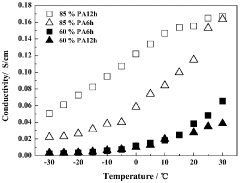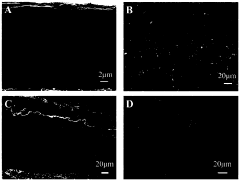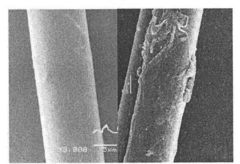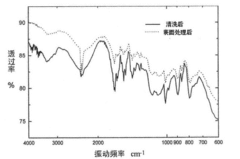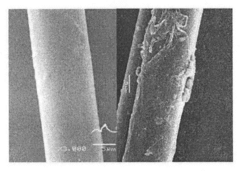Kevlar Fiber Technology in Modern Manufacturing Processes
JUL 10, 20259 MIN READ
Generate Your Research Report Instantly with AI Agent
Patsnap Eureka helps you evaluate technical feasibility & market potential.
Kevlar Fiber Evolution
Kevlar fiber technology has undergone significant evolution since its initial development in the 1960s. The journey of Kevlar began with Stephanie Kwolek's groundbreaking discovery at DuPont, where she synthesized a polymer with exceptional strength-to-weight ratio. This innovation marked the birth of aramid fibers, with Kevlar emerging as the flagship product.
In the early stages, Kevlar was primarily utilized in tire reinforcement and bulletproof vests. As manufacturing processes improved, its applications expanded rapidly. The 1970s saw the introduction of Kevlar into aerospace and automotive industries, where its lightweight yet robust properties proved invaluable. This period also witnessed the refinement of spinning techniques, enabling the production of finer and more uniform Kevlar fibers.
The 1980s and 1990s brought about significant advancements in Kevlar's molecular structure manipulation. Researchers developed methods to align polymer chains more precisely, resulting in even stronger and more versatile fibers. This era also saw the introduction of hybrid Kevlar composites, combining the fiber with other materials to enhance specific properties for targeted applications.
Entering the 21st century, nanotechnology began to play a crucial role in Kevlar's evolution. The integration of nanoparticles and the development of nanostructured Kevlar fibers led to substantial improvements in strength, heat resistance, and electrical conductivity. This breakthrough opened up new possibilities in electronics and smart textiles.
Recent years have witnessed a focus on sustainable manufacturing processes for Kevlar. Efforts to reduce the environmental impact of production have resulted in more eco-friendly synthesis methods and the exploration of bio-based precursors. Additionally, advancements in recycling technologies have improved the lifecycle management of Kevlar products.
The evolution of Kevlar has also been marked by continuous improvements in its chemical resistance and thermal stability. These enhancements have expanded its use in extreme environments, from deep-sea applications to space exploration. The development of specialized Kevlar variants, each tailored for specific performance characteristics, has further diversified its application portfolio.
Looking ahead, the evolution of Kevlar fiber technology is poised to continue its trajectory of innovation. Research is underway to develop self-healing Kevlar composites, incorporate smart functionalities, and further push the boundaries of strength-to-weight ratios. As manufacturing processes become more sophisticated, the potential for customized Kevlar solutions tailored to specific industry needs grows, promising exciting developments in fields ranging from personal protection to advanced engineering applications.
In the early stages, Kevlar was primarily utilized in tire reinforcement and bulletproof vests. As manufacturing processes improved, its applications expanded rapidly. The 1970s saw the introduction of Kevlar into aerospace and automotive industries, where its lightweight yet robust properties proved invaluable. This period also witnessed the refinement of spinning techniques, enabling the production of finer and more uniform Kevlar fibers.
The 1980s and 1990s brought about significant advancements in Kevlar's molecular structure manipulation. Researchers developed methods to align polymer chains more precisely, resulting in even stronger and more versatile fibers. This era also saw the introduction of hybrid Kevlar composites, combining the fiber with other materials to enhance specific properties for targeted applications.
Entering the 21st century, nanotechnology began to play a crucial role in Kevlar's evolution. The integration of nanoparticles and the development of nanostructured Kevlar fibers led to substantial improvements in strength, heat resistance, and electrical conductivity. This breakthrough opened up new possibilities in electronics and smart textiles.
Recent years have witnessed a focus on sustainable manufacturing processes for Kevlar. Efforts to reduce the environmental impact of production have resulted in more eco-friendly synthesis methods and the exploration of bio-based precursors. Additionally, advancements in recycling technologies have improved the lifecycle management of Kevlar products.
The evolution of Kevlar has also been marked by continuous improvements in its chemical resistance and thermal stability. These enhancements have expanded its use in extreme environments, from deep-sea applications to space exploration. The development of specialized Kevlar variants, each tailored for specific performance characteristics, has further diversified its application portfolio.
Looking ahead, the evolution of Kevlar fiber technology is poised to continue its trajectory of innovation. Research is underway to develop self-healing Kevlar composites, incorporate smart functionalities, and further push the boundaries of strength-to-weight ratios. As manufacturing processes become more sophisticated, the potential for customized Kevlar solutions tailored to specific industry needs grows, promising exciting developments in fields ranging from personal protection to advanced engineering applications.
Market Demand Analysis
The market demand for Kevlar fiber technology in modern manufacturing processes has been steadily increasing due to its exceptional properties and versatile applications. Kevlar, a high-strength synthetic fiber developed by DuPont, has found widespread use across various industries, driving its market growth.
In the automotive sector, Kevlar fiber technology has gained significant traction. The material's lightweight nature and high tensile strength make it ideal for manufacturing automotive components, such as tires, brake pads, and body panels. As the automotive industry continues to focus on fuel efficiency and safety, the demand for Kevlar-based products is expected to rise further.
The aerospace industry represents another major market for Kevlar fiber technology. The material's high strength-to-weight ratio makes it invaluable in aircraft construction, particularly for components like fuselage panels, wing structures, and interior fittings. With the growing emphasis on fuel efficiency and reduced emissions in aviation, the demand for lightweight materials like Kevlar is projected to increase substantially.
In the defense and military sector, Kevlar's ballistic resistance properties have made it a crucial material for personal protective equipment, such as bulletproof vests and helmets. The ongoing global focus on enhancing soldier safety and modernizing military equipment continues to drive the demand for Kevlar-based products in this sector.
The sports and recreation industry has also embraced Kevlar fiber technology. Its use in high-performance sporting goods, including bicycle tires, tennis rackets, and protective gear, has led to increased market demand. As consumers seek more durable and lightweight sporting equipment, the adoption of Kevlar-based products is expected to grow.
The construction industry has found valuable applications for Kevlar fiber technology in reinforcing concrete structures and enhancing the strength of building materials. The material's resistance to corrosion and high tensile strength make it an attractive option for infrastructure projects, particularly in seismic-prone areas.
Market analysis indicates that the global Kevlar fiber market is poised for substantial growth in the coming years. Factors such as increasing industrialization, growing safety concerns, and the need for high-performance materials in various applications are driving this growth. The Asia-Pacific region, in particular, is expected to witness significant demand due to rapid industrialization and infrastructure development.
However, the high cost of Kevlar fiber production remains a challenge for market expansion. Manufacturers are actively exploring ways to optimize production processes and reduce costs to make Kevlar-based products more accessible across different industries. Additionally, ongoing research and development efforts are focused on enhancing the material's properties and exploring new applications, which could further stimulate market demand in the future.
In the automotive sector, Kevlar fiber technology has gained significant traction. The material's lightweight nature and high tensile strength make it ideal for manufacturing automotive components, such as tires, brake pads, and body panels. As the automotive industry continues to focus on fuel efficiency and safety, the demand for Kevlar-based products is expected to rise further.
The aerospace industry represents another major market for Kevlar fiber technology. The material's high strength-to-weight ratio makes it invaluable in aircraft construction, particularly for components like fuselage panels, wing structures, and interior fittings. With the growing emphasis on fuel efficiency and reduced emissions in aviation, the demand for lightweight materials like Kevlar is projected to increase substantially.
In the defense and military sector, Kevlar's ballistic resistance properties have made it a crucial material for personal protective equipment, such as bulletproof vests and helmets. The ongoing global focus on enhancing soldier safety and modernizing military equipment continues to drive the demand for Kevlar-based products in this sector.
The sports and recreation industry has also embraced Kevlar fiber technology. Its use in high-performance sporting goods, including bicycle tires, tennis rackets, and protective gear, has led to increased market demand. As consumers seek more durable and lightweight sporting equipment, the adoption of Kevlar-based products is expected to grow.
The construction industry has found valuable applications for Kevlar fiber technology in reinforcing concrete structures and enhancing the strength of building materials. The material's resistance to corrosion and high tensile strength make it an attractive option for infrastructure projects, particularly in seismic-prone areas.
Market analysis indicates that the global Kevlar fiber market is poised for substantial growth in the coming years. Factors such as increasing industrialization, growing safety concerns, and the need for high-performance materials in various applications are driving this growth. The Asia-Pacific region, in particular, is expected to witness significant demand due to rapid industrialization and infrastructure development.
However, the high cost of Kevlar fiber production remains a challenge for market expansion. Manufacturers are actively exploring ways to optimize production processes and reduce costs to make Kevlar-based products more accessible across different industries. Additionally, ongoing research and development efforts are focused on enhancing the material's properties and exploring new applications, which could further stimulate market demand in the future.
Technical Challenges
Kevlar fiber technology, while revolutionary in its inception, faces several significant challenges in modern manufacturing processes. One of the primary obstacles is the high cost associated with production. The complex synthesis process of Kevlar, involving the polymerization of para-phenylenediamine and terephthaloyl chloride, requires specialized equipment and stringent environmental controls, driving up manufacturing expenses.
Another major challenge lies in the scalability of production. While Kevlar's unique properties make it highly desirable for various applications, increasing production to meet growing demand without compromising quality remains a significant hurdle. The intricate spinning process, crucial for achieving the fiber's exceptional strength-to-weight ratio, is particularly difficult to scale up efficiently.
Environmental concerns also pose challenges in Kevlar manufacturing. The production process involves the use of harsh chemicals, including sulfuric acid, which can have detrimental effects on the environment if not properly managed. Developing more eco-friendly production methods without sacrificing the fiber's performance characteristics is an ongoing challenge for manufacturers.
The energy-intensive nature of Kevlar production presents another obstacle. The high temperatures required for polymerization and the subsequent cooling processes contribute significantly to the overall energy consumption and carbon footprint of manufacturing facilities. Balancing energy efficiency with maintaining the fiber's superior properties is a complex task that requires continuous innovation.
Kevlar's limited processability also poses challenges in manufacturing. The fiber's high melting point and resistance to solvents, while beneficial for its end-use applications, make it difficult to process and incorporate into composite materials. This limitation restricts its potential applications and requires the development of specialized manufacturing techniques.
Quality control in Kevlar production is another critical challenge. Ensuring consistent fiber properties, such as tensile strength and modulus, across large production batches is essential but technically demanding. Even minor variations in the manufacturing process can lead to significant deviations in the fiber's performance characteristics.
Lastly, the development of new Kevlar variants to meet evolving market demands presents ongoing technical challenges. While the basic Kevlar structure offers exceptional properties, tailoring these properties for specific applications, such as improved heat resistance or enhanced flexibility, requires extensive research and development efforts. Balancing these modifications without compromising the core strengths of Kevlar remains a complex endeavor in the field of advanced materials science.
Another major challenge lies in the scalability of production. While Kevlar's unique properties make it highly desirable for various applications, increasing production to meet growing demand without compromising quality remains a significant hurdle. The intricate spinning process, crucial for achieving the fiber's exceptional strength-to-weight ratio, is particularly difficult to scale up efficiently.
Environmental concerns also pose challenges in Kevlar manufacturing. The production process involves the use of harsh chemicals, including sulfuric acid, which can have detrimental effects on the environment if not properly managed. Developing more eco-friendly production methods without sacrificing the fiber's performance characteristics is an ongoing challenge for manufacturers.
The energy-intensive nature of Kevlar production presents another obstacle. The high temperatures required for polymerization and the subsequent cooling processes contribute significantly to the overall energy consumption and carbon footprint of manufacturing facilities. Balancing energy efficiency with maintaining the fiber's superior properties is a complex task that requires continuous innovation.
Kevlar's limited processability also poses challenges in manufacturing. The fiber's high melting point and resistance to solvents, while beneficial for its end-use applications, make it difficult to process and incorporate into composite materials. This limitation restricts its potential applications and requires the development of specialized manufacturing techniques.
Quality control in Kevlar production is another critical challenge. Ensuring consistent fiber properties, such as tensile strength and modulus, across large production batches is essential but technically demanding. Even minor variations in the manufacturing process can lead to significant deviations in the fiber's performance characteristics.
Lastly, the development of new Kevlar variants to meet evolving market demands presents ongoing technical challenges. While the basic Kevlar structure offers exceptional properties, tailoring these properties for specific applications, such as improved heat resistance or enhanced flexibility, requires extensive research and development efforts. Balancing these modifications without compromising the core strengths of Kevlar remains a complex endeavor in the field of advanced materials science.
Current Manufacturing
01 Kevlar fiber composition and manufacturing
This category focuses on the composition of Kevlar fibers and their manufacturing processes. It includes methods for producing high-strength aramid fibers, modifications to improve their properties, and techniques for spinning and processing Kevlar fibers. The manufacturing processes may involve specific temperature and pressure conditions, as well as the use of specialized solvents and additives.- Kevlar fiber composition and manufacturing: This category focuses on the composition of Kevlar fibers and their manufacturing processes. It includes innovations in the chemical structure, polymer synthesis, and production techniques to enhance the fiber's properties such as strength, durability, and heat resistance.
- Kevlar fiber applications in protective gear: This point covers the use of Kevlar fibers in various protective equipment and clothing. It includes applications in bulletproof vests, helmets, gloves, and other safety gear designed to provide high-level protection against impacts, cuts, and ballistic threats.
- Kevlar fiber reinforced composites: This category deals with the incorporation of Kevlar fibers into composite materials. It includes methods for combining Kevlar with other materials like resins, polymers, or other fibers to create high-performance composites for use in aerospace, automotive, and industrial applications.
- Kevlar fiber surface treatments and modifications: This point focuses on techniques for modifying the surface properties of Kevlar fibers. It includes chemical treatments, coatings, and other processes to improve adhesion, dyeability, or compatibility with other materials, enhancing the fiber's performance in various applications.
- Kevlar fiber in advanced textile structures: This category covers the use of Kevlar fibers in creating advanced textile structures. It includes innovations in weaving, knitting, and braiding techniques to produce fabrics and structures with enhanced properties for specialized applications such as aerospace, military, and high-performance sportswear.
02 Kevlar fiber applications in protective equipment
Kevlar fibers are widely used in various protective equipment due to their high strength and heat resistance. This category covers applications in body armor, helmets, gloves, and other protective gear. The fibers may be combined with other materials or woven into specific patterns to enhance their protective properties for different types of threats, including ballistic, cut, and heat resistance.Expand Specific Solutions03 Kevlar fiber reinforced composites
This category deals with the use of Kevlar fibers as reinforcement in composite materials. It includes methods for incorporating Kevlar fibers into various matrix materials such as polymers, resins, and metals. The composites may be designed for specific applications requiring high strength-to-weight ratios, impact resistance, or thermal stability. Techniques for improving fiber-matrix adhesion and optimizing composite properties are also covered.Expand Specific Solutions04 Kevlar fiber in aerospace and automotive applications
Kevlar fibers find extensive use in aerospace and automotive industries due to their lightweight and high-strength properties. This category includes applications such as aircraft components, spacecraft heat shields, automotive body panels, and tire reinforcements. The fibers may be used in various forms, including woven fabrics, unidirectional tapes, or chopped fibers, depending on the specific application requirements.Expand Specific Solutions05 Surface modification and functionalization of Kevlar fibers
This category focuses on methods for modifying the surface properties of Kevlar fibers to enhance their performance or enable new applications. It includes techniques such as chemical treatments, plasma modification, and coating processes. These modifications can improve fiber-matrix adhesion in composites, enhance moisture resistance, or introduce new functionalities such as electrical conductivity or antimicrobial properties.Expand Specific Solutions
Key Industry Players
The Kevlar fiber technology market in modern manufacturing processes is in a mature growth stage, with a global market size expected to reach several billion dollars by 2025. The technology has achieved high levels of maturity, with established applications across various industries. Key players like DuPont de Nemours, Inc., the original developer of Kevlar, continue to dominate the market. However, competition is intensifying with the entry of new players and ongoing research at institutions like Indian Institute of Technology Madras and Donghua University. Companies such as Sumitomo Electric Industries Ltd. and Saint-Gobain Abrasives Ltd. are also contributing to advancements in high-performance fiber technologies, expanding the competitive landscape and driving innovation in manufacturing processes.
FCA US LLC
Technical Solution: FCA US LLC (now part of Stellantis) has incorporated Kevlar fiber technology into their automotive manufacturing processes. They have developed a patented method for integrating Kevlar fibers into injection-molded plastic components, significantly enhancing the impact resistance and durability of interior and exterior vehicle parts[8]. FCA's manufacturing process includes a specialized fiber alignment technique that optimizes the orientation of Kevlar fibers within the plastic matrix, resulting in improved mechanical properties[9]. They have also pioneered the use of Kevlar-reinforced composites in vehicle body panels, achieving weight reduction while maintaining crash performance standards[10].
Strengths: Innovative use of Kevlar in automotive applications, weight reduction capabilities. Weaknesses: Potentially higher material costs compared to traditional automotive materials.
Northrop Grumman Systems Corp.
Technical Solution: Northrop Grumman has integrated Kevlar fiber technology into their advanced manufacturing processes for aerospace and defense applications. They have developed a proprietary method for weaving Kevlar fibers into complex 3D structures, enhancing the material's impact resistance and reducing overall weight in aircraft components[5]. Their manufacturing process includes a specialized resin infusion technique that optimizes the bonding between Kevlar fibers and matrix materials, resulting in superior composite performance[6]. Northrop Grumman has also pioneered the use of Kevlar in additive manufacturing, creating hybrid 3D-printed structures with embedded Kevlar reinforcement for unmanned aerial vehicles (UAVs) and satellite components[7].
Strengths: Advanced integration of Kevlar in aerospace applications, innovative 3D weaving techniques. Weaknesses: Limited to specialized, high-end applications, potentially high production costs.
Core Kevlar Innovations
Method for preparing layered-structure low-temperature proton exchange membrane based on vacuum-assisted flocculation technology
PatentInactiveCN110556559A
Innovation
- Vacuum-assisted flocculation technology was used to prepare a low-temperature proton exchange membrane with a layered structure. By using Kevlar fiber, oxidized carbon nanotubes and polyvinyl alcohol as raw materials, vacuum-assisted flocculation technology was used to achieve the orderly assembly of the three components to prepare Non-aqueous proton exchange membrane with high proton conductivity and good mechanical properties.
Method for modifying aramid fiber by using carbon nano tubes
PatentInactiveCN101831800B
Innovation
- Carbon nanotubes are used to modify the surface of the aramid fiber, and free amino groups are formed through isocyanate treatment. Combined with carboxylated carbon nanotubes for ultrasonic-assisted soaking, amide bonds are formed to fix the carbon nanotubes on the surface and inside of the fiber to improve the surface of the fiber. Adhesion and mechanical properties.
Sustainability Aspects
Kevlar fiber technology has made significant strides in enhancing sustainability within modern manufacturing processes. The inherent properties of Kevlar, such as its high strength-to-weight ratio and durability, contribute to the production of longer-lasting products, reducing the need for frequent replacements and thereby minimizing waste generation.
In the automotive industry, Kevlar's lightweight nature allows for the creation of vehicles with improved fuel efficiency, directly contributing to reduced carbon emissions. Similarly, in aerospace applications, the use of Kevlar in aircraft components leads to weight reduction, resulting in decreased fuel consumption and a lower environmental impact during operation.
The manufacturing process of Kevlar itself has seen improvements in sustainability. Advancements in production techniques have led to more efficient use of raw materials and energy. Some manufacturers have implemented closed-loop systems, recovering and reusing solvents used in the production process, significantly reducing chemical waste and environmental impact.
Recycling initiatives for Kevlar-based products have gained traction in recent years. While challenging due to the fiber's durability, innovative methods are being developed to break down and repurpose Kevlar materials at the end of their lifecycle. This not only reduces landfill waste but also decreases the demand for virgin raw materials in new product manufacturing.
In the construction sector, Kevlar's use in reinforcing materials has led to more durable and energy-efficient buildings. Its application in concrete reinforcement, for instance, results in structures with longer lifespans and reduced maintenance requirements, contributing to overall resource conservation.
The water treatment industry has also benefited from Kevlar's sustainability aspects. Kevlar-based filtration systems offer improved efficiency and longevity compared to traditional materials, leading to reduced energy consumption and less frequent filter replacements.
Looking ahead, research is ongoing to further enhance the sustainability of Kevlar production and application. This includes exploring bio-based precursors for Kevlar synthesis, which could potentially reduce reliance on petroleum-derived raw materials. Additionally, efforts are being made to optimize the energy intensity of the manufacturing process, with the goal of reducing the overall carbon footprint of Kevlar production.
In the automotive industry, Kevlar's lightweight nature allows for the creation of vehicles with improved fuel efficiency, directly contributing to reduced carbon emissions. Similarly, in aerospace applications, the use of Kevlar in aircraft components leads to weight reduction, resulting in decreased fuel consumption and a lower environmental impact during operation.
The manufacturing process of Kevlar itself has seen improvements in sustainability. Advancements in production techniques have led to more efficient use of raw materials and energy. Some manufacturers have implemented closed-loop systems, recovering and reusing solvents used in the production process, significantly reducing chemical waste and environmental impact.
Recycling initiatives for Kevlar-based products have gained traction in recent years. While challenging due to the fiber's durability, innovative methods are being developed to break down and repurpose Kevlar materials at the end of their lifecycle. This not only reduces landfill waste but also decreases the demand for virgin raw materials in new product manufacturing.
In the construction sector, Kevlar's use in reinforcing materials has led to more durable and energy-efficient buildings. Its application in concrete reinforcement, for instance, results in structures with longer lifespans and reduced maintenance requirements, contributing to overall resource conservation.
The water treatment industry has also benefited from Kevlar's sustainability aspects. Kevlar-based filtration systems offer improved efficiency and longevity compared to traditional materials, leading to reduced energy consumption and less frequent filter replacements.
Looking ahead, research is ongoing to further enhance the sustainability of Kevlar production and application. This includes exploring bio-based precursors for Kevlar synthesis, which could potentially reduce reliance on petroleum-derived raw materials. Additionally, efforts are being made to optimize the energy intensity of the manufacturing process, with the goal of reducing the overall carbon footprint of Kevlar production.
Safety Regulations
Safety regulations play a crucial role in the implementation and use of Kevlar fiber technology in modern manufacturing processes. As this high-strength synthetic fiber finds increasing applications across various industries, it is essential to establish and adhere to comprehensive safety guidelines to protect workers, consumers, and the environment.
In the manufacturing sector, the production of Kevlar fibers involves handling potentially hazardous chemicals and high-temperature processes. Regulatory bodies such as the Occupational Safety and Health Administration (OSHA) in the United States have set strict standards for workplace safety in facilities producing and processing Kevlar. These regulations cover aspects such as proper ventilation, personal protective equipment (PPE), and emergency response protocols.
The use of Kevlar in protective gear, such as bulletproof vests and helmets, is subject to rigorous testing and certification processes. Organizations like the National Institute of Justice (NIJ) in the U.S. have established performance standards that Kevlar-based protective equipment must meet to ensure the safety of law enforcement and military personnel.
In the automotive and aerospace industries, where Kevlar is increasingly used for lightweight components, safety regulations focus on material integrity and fire resistance. Standards set by bodies like the Federal Aviation Administration (FAA) and the National Highway Traffic Safety Administration (NHTSA) dictate the performance requirements for Kevlar-reinforced parts in vehicles and aircraft.
Environmental regulations also play a significant role in Kevlar manufacturing. The production process involves the use of solvents and other chemicals that require careful handling and disposal. Agencies such as the Environmental Protection Agency (EPA) in the U.S. have established guidelines for the safe management of these materials to prevent environmental contamination.
As Kevlar finds new applications in emerging fields like 3D printing and smart textiles, regulatory bodies are working to develop new safety standards. These regulations aim to address potential risks associated with novel manufacturing techniques and the integration of electronic components into Kevlar-based materials.
International standards organizations, such as the International Organization for Standardization (ISO), are working to harmonize safety regulations for Kevlar across different countries. This effort is crucial for ensuring consistent safety practices in global supply chains and facilitating international trade in Kevlar-based products.
Ongoing research into the long-term health effects of Kevlar exposure continues to inform and shape safety regulations. While Kevlar is generally considered safe for use, regulatory bodies remain vigilant in monitoring potential risks and updating guidelines as new information becomes available.
In the manufacturing sector, the production of Kevlar fibers involves handling potentially hazardous chemicals and high-temperature processes. Regulatory bodies such as the Occupational Safety and Health Administration (OSHA) in the United States have set strict standards for workplace safety in facilities producing and processing Kevlar. These regulations cover aspects such as proper ventilation, personal protective equipment (PPE), and emergency response protocols.
The use of Kevlar in protective gear, such as bulletproof vests and helmets, is subject to rigorous testing and certification processes. Organizations like the National Institute of Justice (NIJ) in the U.S. have established performance standards that Kevlar-based protective equipment must meet to ensure the safety of law enforcement and military personnel.
In the automotive and aerospace industries, where Kevlar is increasingly used for lightweight components, safety regulations focus on material integrity and fire resistance. Standards set by bodies like the Federal Aviation Administration (FAA) and the National Highway Traffic Safety Administration (NHTSA) dictate the performance requirements for Kevlar-reinforced parts in vehicles and aircraft.
Environmental regulations also play a significant role in Kevlar manufacturing. The production process involves the use of solvents and other chemicals that require careful handling and disposal. Agencies such as the Environmental Protection Agency (EPA) in the U.S. have established guidelines for the safe management of these materials to prevent environmental contamination.
As Kevlar finds new applications in emerging fields like 3D printing and smart textiles, regulatory bodies are working to develop new safety standards. These regulations aim to address potential risks associated with novel manufacturing techniques and the integration of electronic components into Kevlar-based materials.
International standards organizations, such as the International Organization for Standardization (ISO), are working to harmonize safety regulations for Kevlar across different countries. This effort is crucial for ensuring consistent safety practices in global supply chains and facilitating international trade in Kevlar-based products.
Ongoing research into the long-term health effects of Kevlar exposure continues to inform and shape safety regulations. While Kevlar is generally considered safe for use, regulatory bodies remain vigilant in monitoring potential risks and updating guidelines as new information becomes available.
Unlock deeper insights with Patsnap Eureka Quick Research — get a full tech report to explore trends and direct your research. Try now!
Generate Your Research Report Instantly with AI Agent
Supercharge your innovation with Patsnap Eureka AI Agent Platform!

